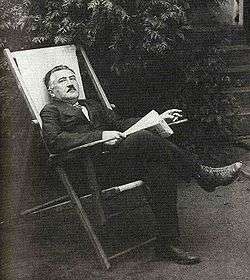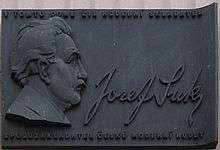Josef Suk (composer)

| Medal record | ||
|---|---|---|
| Art competitions | ||
| Representing | ||
| Olympic Games | ||
| | 1932 Los Angeles | Music |
Josef Suk (4 January 1874 – 29 May 1935) was a Czech composer and violinist. He studied under Antonín Dvořák, whose daughter he married.
Biography
From a young age, Josef Suk was deeply involved and well-trained in music. He learned organ, violin, and piano from his father, Josef Suk senior, and was trained further in violin by the Czech violinist Antonín Bennewitz. His theory studies were conducted with several other composers including Josef Bohuslav Foerster, Karel Knittl, and Karel Stecker. He later focused his writing on chamber works under the teachings of Hanuš Wihan.[1] Despite extensive musical training, his musical skill was often said to be largely inherited.[2] Though he continued his lessons with Wihan another year after the completion of his schooling, Suk's greatest inspiration came from another of his teachers, Czech composer Antonín Dvořák.[3]
Because of their shared heritage - and furthered by the coincidence of dying within a year of one another - Suk's works and style have been closely compared to Czech composer Otakar Ostrčil.[4] Known as one of Dvořák's favorite pupils, Suk became very close to Dvořák .[5] Underlying this was Dvořák's respect for Suk, reflected in Suk's subsequent marriage to Dvořák's daughter, Otilie: marking some of the happiest times in the composer's life and music.[6] However, the last portion of Suk's life was punctuated with tragedy.[7] Over the span of 14 months around 1905, not only did Suk's mentor, Dvořák, die, but so did Otilie. These events inspired Suk's Asrael Symphony. Suk retired in 1933,[3] although he continued to be a very valuable and inspirational public figure to the Czechs.[8]
Suk, alongside Vitezslav Novak and Ostrčil, is considered one of the leading composers in Czech Modernism, with much of this influence coming from Dvořák.[9] Popular composers, such as Johannes Brahms and Eduard Hanslick, recognized Suk's work during his time with the Czech Quartet.[3] Over time, other well-known Austrian composers, like Gustav Mahler and Alban Berg, began to take notice of Suk and his work.[5] Although he wrote mostly instrumental music, Suk occasionally branched out into other genres. Orchestral music was his strong suit, notably the Serenade for Strings, Op. 6 (1892).[3] His time with the Czech Quartet, though performing successful concerts until his retirement,[3] was not always met with public approval. Several anti-Dvořák campaigns came into prominence; criticism not only being directed at the quartet, but towards Suk specifically. Zdeněk Nejedlý accused the Czech Quartet of inappropriately playing concerts in the Czech lands during a time of war. While these attacks diminished Suk's spirits, they did not hinder his work.[10]
Suk is the grandfather of famed Czech violinist Josef Suk.[11]
Musical style
 |
Meditation on the Saint Wenceslas Chorale, Op. 35a
Performed by Musopen String Quartet |
| Problems playing this file? See media help. | |
Suk's musical style started off with a very heavy emphasis on what he experienced during his time with Dvořák. The biggest change of Suk's style came after a "dead end" in his musical lifestyle (music played less of a role in Suk's life outside of his schooling[3]) just before he began the shift of style during 1897–1905, perhaps realizing that his known Dvořák influence would restrain his work.[5] Morbidity was always a large factor in Suk's music. For instance, he wrote his own funeral march in 1889 and it appears significantly also in his major work, funeral symphony Asrael. Ripening, a symphony, was also a story of pain and questioning the value of life. Others of his works represent his happiness, such as the music he set to Julius Zeyer's drama Radúz a Mahulena (which he referenced to his marriage with Otilie). Another of Suk's works, Pohádka ('Fairy Tale'), was drawn from his work with Radúz a Mahulena. The closest Suk came to working with opera is music his wrote for the play Pod jabloní or 'Beneath the Apple Tree'.[12]
The majority of Suk's papers are kept in Prague. There is also a new catalogue of Suk's works that contains more manuscripts than any before it, some of them also containing sketches by Suk.[13]
Suk said of himself: "I do not bow to anyone, except to my own conscience and to our noble Lady Music… and yet at the same time I know that thereby I serve my country, and praise the great people from the period of our wakening who taught us to love our country."[14]
Chronological list of compositions

- 1888 String Quartet (0) in D minor (Barcarolle in B flat & Andante con moto survive)
- 1889 Piano Trio in C minor, Op. 2 (rev. 1890–91)
- 1890 Ballade in D minor, for string quartet or violin & piano
- 1890 Ballade in D minor, Op. 3, No. 1, cello & piano (rev. 1898)
- 1890 Serenade in A, cello & piano, Op. 3, No. 2 (rev. 1898)
- 1891 Three Songs without Words, piano
- 1891 Piano Quartet in A minor, Op. 1
- 1891–92 Dramatic Overture, Op. 4, orchestra
- 1891–93 Six Pieces for piano, Op. 7
- 1892 Fantasy-Polonaise, piano, Op. 5
- 1892 Serenade for Strings in E flat, Op. 6
- 1893 Melody for young violinists, for 2 violins
- 1893 Piano Quintet in G minor, Op. 8 (rev. 1915)
- 1894 A Winter's Tale, Shakespeare Overture for orchestra, Op. 9 (rev. 1926)
- 1894 Humoresque in C, piano (or 1897)
- 1895 Album Leaf, piano
- 1895 Five Moods, Op. 10, piano
- 1895–96 Eight Pieces, Op. 12, piano
- 1896 String Quartet No. 1 in B flat, Op. 11 : Finale Allegro Giocoso (second version; rev. 1915)
- 1896 String Quartet No. 1 in B flat, Op. 11
- 1897 Piano Sonatina in G minor, Op. 13 : Andante, included in Four Episodes for piano
- 1897 Suite for piano, Op. 13 (rev. 1900 as Op. 21)
- 1897 Piano Sonatina in G minor, Op. 13 (rev. 1900; Minuet arr. string quartet, Op. 21a)
- 1897 Village Serenade for piano
- 1897–98 Raduz & Mahulena: A Fairy Tale Suite for orchestra, Op. 16 (rev. 1912)
- 1897–99 Symphony No. 1 in E, Op. 14
- 1898 Bagatelle, Op. 14, piano (originally the third movement of Symphony No. 1 in E)
- 1900 Four Pieces for violin & piano, Op. 17
- 1901 Under the Apple Tree, Op. 20, cantata after Zeyer for mezzo-soprano & orchestra, arr. 1911–12
- 1902 Spring, Op. 22a, five pieces for piano
- 1902 Summer Impressions, Op. 22b, three pieces for piano
- 1902 Elegy for violin, cello, string quartet, harmonium & harp, Op. 23; also arranged for Piano Trio
- 1903 Fantasy in G minor, violin & orchestra, Op. 24
- 1903 Fantastic Scherzo, Op. 25, orchestra
- 1904 Prague, Op. 26, symphonic poem for orchestra
- 1905–6 Symphony No. 2 in C minor, "Asrael", Op. 27
- 1907 About Mother, five pieces for piano, Op. 28
- 1907–8 A Summer's Tale, Op. 29, orchestra
- 1909 Ella-Polka, included in Four Episodes for piano
- 1909 Things Lived and Dreamed, Op. 30, ten pieces for piano
- 1909 Spanish Joke, piano
- 1910–12 Six Lullabies, Op. 33, piano
- 1911 String Quartet No. 2, Op. 31
- 1912–17 Ripening, Op. 34, symphonic poem for orchestra. with chorus
- 1914 Meditation on the Saint Wenceslas Chorale, Op. 35a, strings or string-quartet
- 1917 Bagatelle with Nosegay in Hand, flute, violin & piano
- 1919 Album Leaf, included in Four Episodes for piano
- 1919 Minuet, violin & piano
- 1919–20 Legend of Dead Victors, Commemoration for orchestra, Op. 35b
- 1919–20 Toward a New Life, Sokol March, Op. 35c, orchestra
- 1920 About Friendship, Op. 36, piano
- 1920–29 Epilogue, Op. 37, text from Zeyer & Psalms, for soprano, baritone, bass, mixed chorus & orchestra, rev. 1930–33
- 1924 About Christmas Day, included in Four Episodes for piano
- 1932 Beneath Blanik, march arr. Kalas for orchestra
- 1935 Sousedská, for five violins, double-bass, cymbals, triangle, side-drum & bass-drum
References
- ↑ Tyrell, John. "Suk, Josef." In Grove Music Online. Oxford Music Online. 1, date accessed: September 25, 2012. http://www.oxfordmusiconline.com/subscriber/article/grove/music/27094
- ↑ Helfert, Vladimir. "Two Losses to Czech Music: Josef Suk and Otakar Ostrčil." The Slavonic and East European Review, Vol. 14, No. 42 (April, 1936). 639, JSTOR. Date accessed: September 30, 2012. http://www.jstor.org/stable/4203158
- 1 2 3 4 5 6 Tyrell, Grove. 1
- ↑ Helfert, "Losses." 649
- 1 2 3 Novak, "Non-Obstinate." 86
- ↑ Helfer, "Losses." 640
- ↑ Novak, "Non-Obstinate." 87
- ↑ Holland, Bernard. "A String Quartet as Family Affair And Showcase for Czech Masters." New York Times 23 July 2004: E10. Gale World History In Context. 1. Date accessed: October 2, 2012).
- ↑ Helfert, "Losses." 641
- ↑ Ed. Jana Vojtěšková. "Josef Suk — dopisy o životě hudebním i lidském." 2005. 1.
- ↑ Alena Němcová. "Suk, Josef (ii)." Grove Music Online. Oxford Music Online. Oxford University Press. Web. 7 Jul. 2015. <http://www.oxfordmusiconline.com/subscriber/article/grove/music/27095>.
- ↑ Tyrell, Grove. 2
- ↑ John Tyrrell. "Josef Suk: Tematický katalog skladeb/Thematic Catalogue of the Works (JSkat) (review)." Music and Letters 90, no. 3 (2009): 501-503.
- ↑ Beckerman, Michael. "In Search of Czechness in Music." 19th-Century Music, Vol. 10, No. 1 (Summer, 1986). 63, date accessed: October 2, 2012. JSTOR 746749
Sources
- Černušák, Gracián (ed.); Štědroň, Bohumír; Nováček, Zdenko (ed.) (1965). Československý hudební slovník II. M-Ž (in Czech). Prague: Státní hudební vydavatelství. p. 641. Cite uses deprecated parameter
|coauthors=(help)
- The Games of the Xth Olympiad Los Angeles 1932 (PDF). Xth Olympiade Committee of the Games of Los Angeles, U.S.A. 1932. 1933. pp. 748–765. Archived (PDF) from the original on 2008-04-10.
- Wagner, Juergen. "Olympic Art Competition 1932". Olympic Games Museum. Archived from the original on 2008-05-01.
- Kramer, Bernhard (May 2004). "In Search of the Lost Champions of the Olympic Art Contests" (PDF). Journal of Olympic History. 12 (2): 29–34. Archived (PDF) from the original on 2008-04-10.
- "Josef Suk". Olympics at Sports-Reference.com. Sports Reference LLC. Retrieved 2016-05-29.
External links
| Wikimedia Commons has media related to Josef Suk. |
- Video: 1st movement of the Serenade op. 6 played by the Slovak Chamber Orchestra at the 'Indian Summer in Levoča' Festival, 2008. on YouTube
- Photo of Josef and Otilie Suk in a Dvořák Family Photo Gallery
- Free scores by Josef Suk at the International Music Score Library Project
- Josef Suk:Piano Works
- Meet … Czech composer and violinist Josef Suk
- Josef Suk Piano Quartet Op.1, Piano Trio in c, Op.2 and String Quartet No.1, Op.11 Soundbites and discussion of works
- Josef Suk's academic genealogy entry